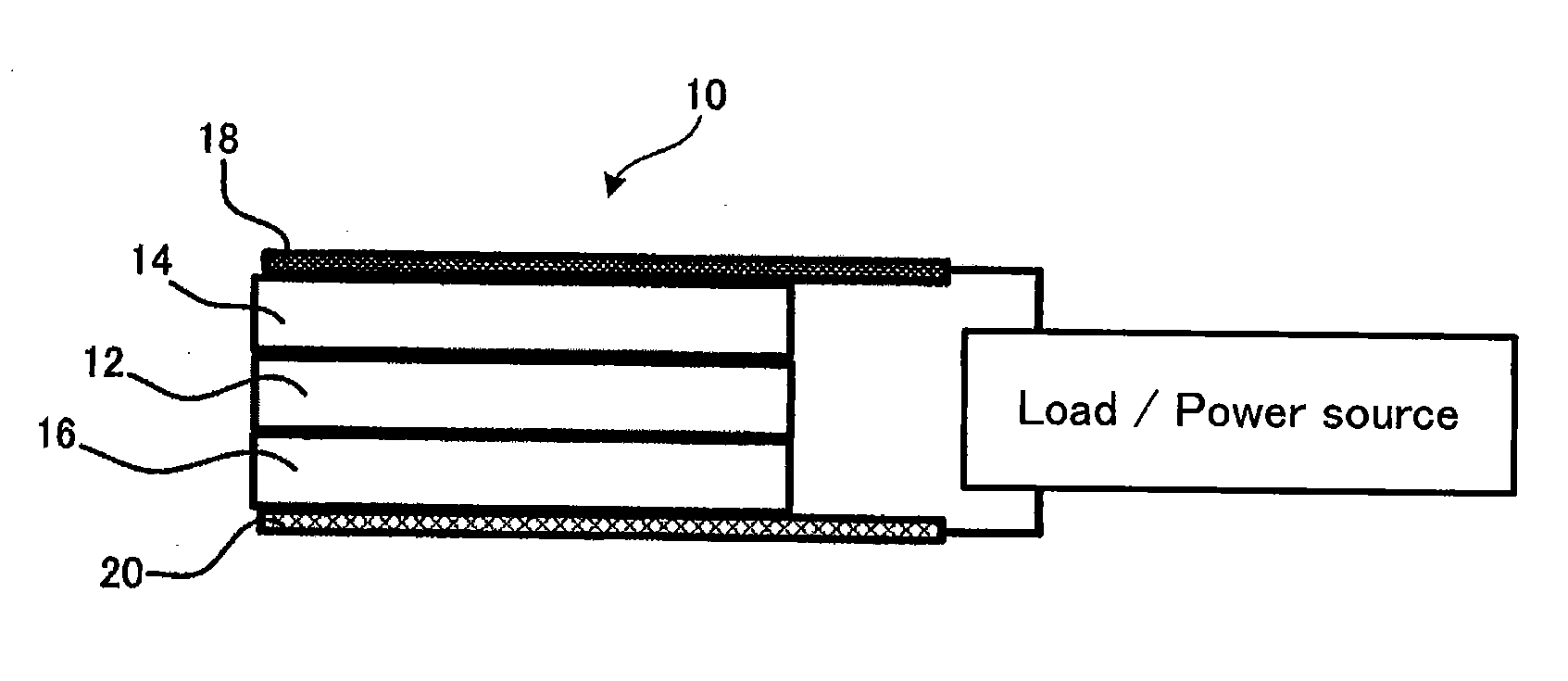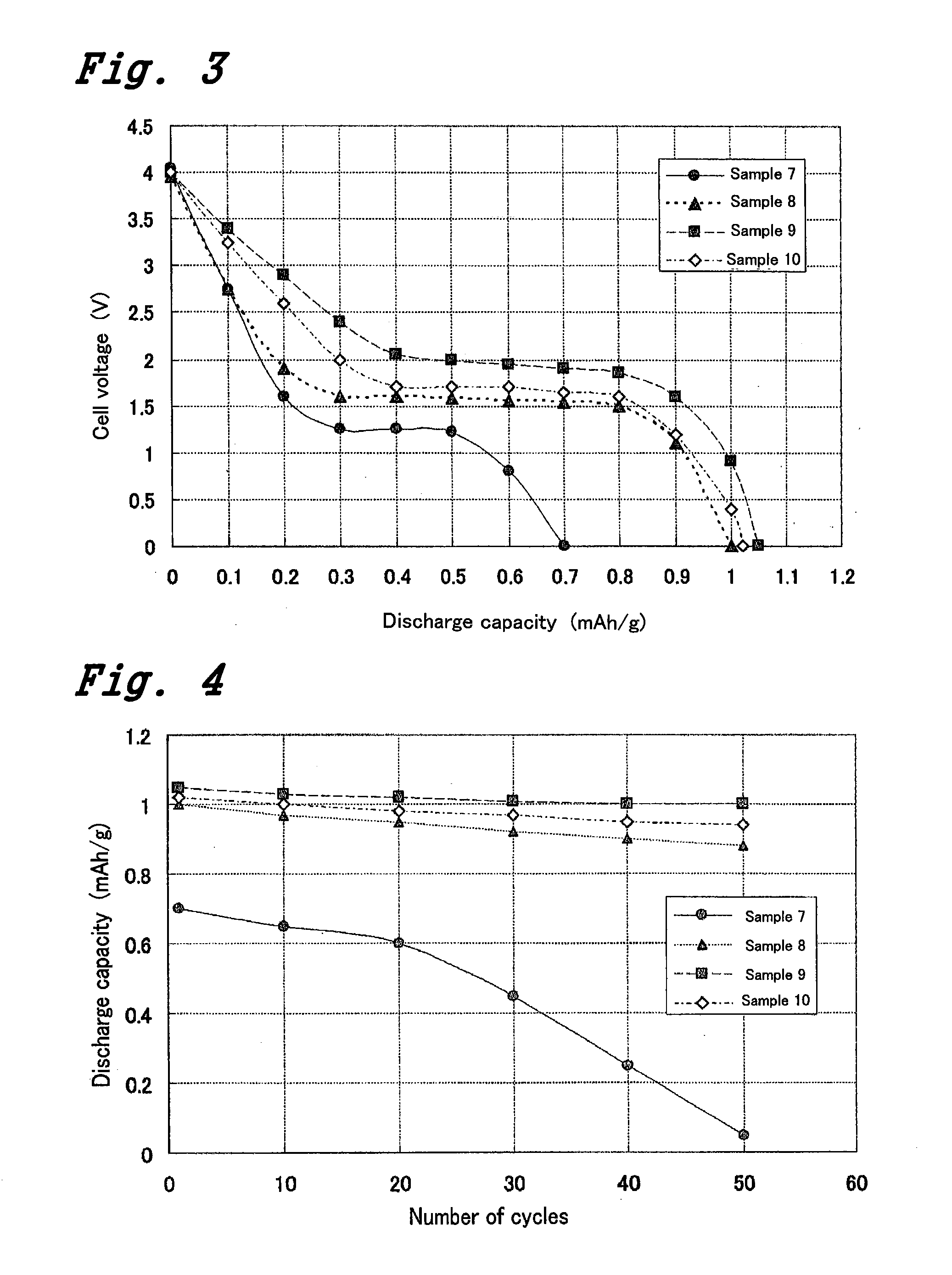All solid state battery
- Summary
- Abstract
- Description
- Claims
- Application Information
AI Technical Summary
Benefits of technology
Problems solved by technology
Method used
Image
Examples
embodiment 1
[0014]Pellets containing solid electrolyte including inorganic substance including a lithium ion conductive crystal were prepared and bulk density and ion conductivity thereof were evaluated with respect to an addition amount of a material constituted of compound including lithium.
(Preparation of Electrolyte)
[0015]As raw materials, H3PO4, Al(PO3)3, Li2CO3, SiO2, and TiO2 are employed. These materials were weighed out to provide a composition of 35.0% P2O5, 7.5% Al2O3, 15.0% Li2O, 38.0% TiO2, and 4.5% SiO2, respectively in mol % as the mixture was placed in a platinum pot, and heated and fused for 4 hours while stirring a fused glass melt at a temperature of 1500° C. in an electric furnace. Thereafter, the glass melt was dripped into running water to obtain glass in a flake form. The thus-obtained glass was subject to a heat treatment at 950° C. for 12 hours such that crystallization might occur in order to obtain glass ceramics as the objective material. It was confirmed that the pr...
embodiment 2
[0022]Electrolyte (powder lithium ion conductive glass ceramics) and an sintering additive (Li3PO4+LiNO3) were mixed and a binder and the like were added to the mixture. Then, the thus-obtained mixture was shaped in a precursor form and thereafter fired to prepare a solid electrolyte body. Such solid electrolyte bodies having the above-mentioned two kinds of sintering additives in varied ratios were prepared and bulk density and ion conductivity were evaluated.
(Preparation of Precursor Solid Electrolyte)
[0023]Solid electrolyte bodies were prepared by a green sheet method (a method of obtaining the thickness of a form using a raw sheet, known as the green sheet, before ceramics are sintered to it) and experiments were conducted. As shown in Table 1, a binder (N-3046 by YUKEN INDUSTRY CO., LTD.) of 30 g, a dispersant (N-1005 by YUKEN INDUSTRY CO., LTD.) of 1.5 g, and water of 20 g for 100 g of the sum of the electrolyte (powder lithium ion conductive glass ceramics) and the sintering ...
embodiment 3
[0030]The battery properties were evaluated as an all solid state batter was configured as shown in FIG. 1. That is, the all solid state battery 10 was configured such that an inorganic solid electrolyte 12 was sandwiched by a negative electrode 14 and a positive electrode 16 being arranged across the inorganic solid electrolyte 12 in a up-and-down direction in the figure and leads were connected with the negative electrode 14 and the positive electrode 16. In this way, the all solid state battery 10 can be charged and discharged in terms of the current.
(Preparation of Positive Electrode Layer Precursor)
[0031]As the positive electrode material, LiNiPO4 manufactured by KOJUNDO CHEMICAL LABORATORY CO., LTD. was milled by the planetary ball mill to attain the average particle diameter of 0.5 μm. Five gram (5 g) of LiNiPO4 and 2.5 g of 20% aqueous sucrose solution were blended and then dried as they were being mixed. The dried power was placed into inside of a graphite crucible and grap...
PUM
| Property | Measurement | Unit |
|---|---|---|
| Temperature | aaaaa | aaaaa |
| Temperature | aaaaa | aaaaa |
| Temperature | aaaaa | aaaaa |
Abstract
Description
Claims
Application Information
 Login to View More
Login to View More - R&D
- Intellectual Property
- Life Sciences
- Materials
- Tech Scout
- Unparalleled Data Quality
- Higher Quality Content
- 60% Fewer Hallucinations
Browse by: Latest US Patents, China's latest patents, Technical Efficacy Thesaurus, Application Domain, Technology Topic, Popular Technical Reports.
© 2025 PatSnap. All rights reserved.Legal|Privacy policy|Modern Slavery Act Transparency Statement|Sitemap|About US| Contact US: help@patsnap.com



